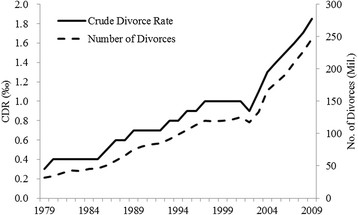A complete list of the major articles published in 2014 with links to other articles. Complete list of articles from.
Divorce continues to be an important area of family and social science research. Below are a few of the studies published in the early part of 2014 that provide insight into divorce issues. Included in this summary are demographic, economic, causes of divorce, adjustment issues for adults and children, divorce education, marriage & relationship education, non-residential parenting and a new report on custody and shared parenting.
Demographic Issues
Bellido, H., & Marcén, M.Divorce laws and fertility. Labour Economics, (0) doi:http://dx.doi.org/10.1016/j.labeco.2014.01.005
Kennedy, S., & Ruggles, S. (2014). Breaking up is hard to count: The rise of divorce in the united states, 1980-2010. Demography, , 1-12. http://dx.doi.org/10.1007/s13524-013-0270-9
Kulu, H. (2014). Marriage duration and divorce: The seven-year itch or a lifelong itch? Demography, , 1-13. http://dx.doi.org/10.1007/s13524-013-0278-1
Divorce & Economics– Especially the Recession
Baghestani, H., & Malcolm, M. (2014). Marriage, divorce and economic activity in the US: 1960-2008. Applied Economics Letters, , 528-532. doi: http://dx.doi.org/10.1080/13504851.2013.872753
Cohen, P. (2014). Recession and divorce in the united states,. Population Research and Policy Review, 1-14. http://dx.doi.org/10.1007/s11113-014-9323-z
Causes of Divorce
Røsand, G. B., Slinning, K., Røysamb, E., & Tambs, K. (2014). Relationship dissatisfaction and other risk factors for future relationship dissolution: A population-based study of 18,523 couples. Social Psychiatry and Psychiatric Epidemiology, 49(1), 109-119. doi:http://dx.doi.org/10.1007/s00127-013-0681-3
Adult Adjustment to Divorce
Kulik, L., & Kasa, Y. (2014). Adjustment to divorce: A comparison of ethiopian immigrant and israeli-born men. Journal of Community Psychology, 42(2), 191-208.
Children’s Adjustment to Divorce
Mandemakers, J. J., & Kalmijn, M. (2014). Do mother’s and father’s education condition the impact of parental divorce on child well-being? Social Science Research, 44(0), 187-199. doi:http://dx.doi.org/10.1016/j.ssresearch.2013.12.003
Non-residential & Shared Parenting Issues
Finzi-Dottan, R., & Cohen, O. (2014). Predictors of parental communication and cooperation among divorcing spouses. Journal of Child and Family Studies, 23(1), 39-51. doi:http://dx.doi.org/10.1007/s10826-012-9684-z
Modecki, K. L., Hagan, M. J., Sandler, I., & Wolchik, S. A. (2014). Latent profiles of nonresidential father engagement six years after divorce predict long-term offspring outcomes. Journal of Clinical Child & Adolescent Psychology, , 1-14. http://dx.doi.org/10.1080/15374416.2013.865193
Rodriguez, S. R. (2014). “We’ll only see parts of each other’s lives:” the role of mundane talk in maintaining nonresidential parent–child relationships. Journal of Social and Personal Relationships,
Aging, Intergenerational Issues and Divorce
Cooney, T. M., Proulx, C. M., Snyder-Rivas, L., & Benson, J. J. (2014). Role ambiguity among women providing care for ex-husbands. Journal of Women & Aging, 26(1), 84-104. http://dx.doi.org/10.1080/08952841.2014.859502
Ganong, L., & Coleman, M. (2014). Responsibility inferences and intergenerational obligations to parents and stepparents: Are Step/Children less obligated when older adults are at fault for their problems? Journal of Divorce & Remarriage, 55(1), 64-81. doi:10.1080/10502556.2013.862098
Stepfamily Issues
Doodson, L. J., & Davies, A. P. C. (2014). Different challenges, different well-being: A comparison of psychological well-being across stepmothers and biological mothers and across four categories of stepmothers. Journal of Divorce & Remarriage, 55(1), 49-63. http://dx.doi.org/10.1080/10502556.2013.862094
Marriage & Relationship Education
Cordova, J. V. (2014). Findings and future directions for marriage checkup research. Washington, DC, US: American Psychological Association, Washington, DC. doi:http://dx.doi.org/10.1037/14321-011
Cordova, J. V. (2014). The marriage checkup practitioner’s guide: Promoting lifelong relationship health. Washington, DC, US: American Psychological Association, Washington, DC. doi:http://dx.doi.org/10.1037/14321-000
Divorce Education
Stallman, H. M., & Sanders, M. R. (2014). A randomized controlled trial of family transitions triple P: A group-administered parenting program to minimize the adverse effects of parental divorce on children. Journal of Divorce & Remarriage, 55(1), 33-48. http://dx.doi.org/10.1080/10502556.2013.862091
Legal Issues and Divorce Services
Pruett, M. K., & DiFonzo, J. H. (2014). Closing the Gap: Research, Policy, Practice and Shared Parenting AFCC Think Tank Final Report to be published in Family Court Review
Research Methods for Divorce Research
Lamela, D., Figueiredo, B., Bastos, A., & Martins, H. (2014). Psychometric properties of the portuguese version of the posttraumatic growth inventory short form among divorced adults. European Journal of Psychological Assessment, 30(1), 3-14. doi:http://dx.doi.org/10.1027/1015-5759/a000161
Other Summaries of divorce research for 2010, 2011, 2012, 2013
